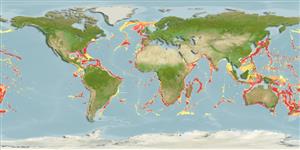分類 / Names
共通名の | 類義語 | Catalog of Fishes(部類, 種) | ITIS | CoL | WoRMS | Cloffa
板鰓亜鋼(サメとエイ類) (sharks and rays) >
Carcharhiniformes (Ground sharks) >
Pseudotriakidae (False catsharks)
Etymology: Pseudotriakis: pseudo-, from pseudes (Gr.), false, i.e., although this genus may superficially resemble Triakis (Triakidae), such an appearance is false. (See ETYFish); microdon: micro-, from mikros (Gr.), small; odon (Gr.), tooth, referring to numerous small teeth (>200 rows in each jaw). (See ETYFish).
Environment: milieu / climate zone / depth range / distribution range
生態学
海 深海魚; 深さの範囲 173 - 1890 m (Ref. 58302). Deep-water; 64°N - 48°S, 98°W - 153°W
Western Atlantic: New York and New Jersey, USA. Reported from Cuba (Ref. 26340); including Brazil (Ref. 53443). Northeast Atlantic: Atlantic slope off Iceland, France, Portugal, Madeira, Azores, Senegal, and Cape Verde. Indian Ocean: Aldabra Island group and Western Australia (Ref. 13565). Pacific Ocean: Japan, Taiwan, New Zealand, and Hawaii (Ref. 13565).
Length at first maturity / サイズ / 重さ / 年齢
Maturity: Lm 253.5, range 210 - 295 cm
Max length : 269 cm TL オス/雌雄の選別がない; (Ref. 244); 295.0 cm TL (female)
簡単な記述
検索表 | 形態学 | 形態計測学
背面の脊椎 (合計) : 0; 肛門の骨: 0. Lower lobe of caudal fin hardly developed, its upper edge not rippled and a subterminal notch present (Ref. 13565). Uniformly dark brownish-grey, darker on posterior edges of pelvic, dorsal, anal and caudal fins (Ref. 13565).
Found on the continental and insular slopes, occasionally wandering onto continental shelves (Ref. 13565). Inactive and sluggish (Ref. 13565). Probably eats bony fishes, elasmobranchs and invertebrates (Ref. 244). Ovoviviparous, embryos feeding on yolk sac and other ova produced by the mother, uterine milk is consumed additionally (Ref. 50449). Pups number 2 to 4 in a litter (Ref. 244), size at birth between 70 (Ref. 244) and 140 cm TL (Ref. 13565). Caught very rarely by deepwater demersal longline fisheries in some areas. Utilized for its fins (limited value), meat and cartilage (Ref.58048).
Exhibit ovoviparity (aplacental viviparity), embryos feed on yolk and ova, also consume uterine milk (Ref. 50449) with 2-4 young in a litter (Ref. 13565; Ref.58048). Size at birth between 70 and 85 cm (Ref. 26346 reports it at about 140 cm TL). Distinct pairing with embrace (Ref. 205).
Compagno, L.J.V., 1984. FAO Species Catalogue. Vol. 4. Sharks of the world. An annotated and illustrated catalogue of shark species known to date. Part 2 - Carcharhiniformes. FAO Fish. Synop. 125(4/2):251-655. Rome: FAO. (Ref. 244)
Human uses
水産業: 食糧水産
用具
特記事項
XMLをダウンロードして下さい
インターネットの情報源
Estimates based on models
Preferred temperature (Ref.
123201): 4.8 - 12.7, mean 8.2 °C (based on 793 cells).
Phylogenetic diversity index (Ref.
82804): PD
50 = 1.0625 [Uniqueness, from 0.5 = low to 2.0 = high].
Bayesian length-weight: a=0.00047 (0.00023 - 0.00095), b=3.29 (3.10 - 3.48), in cm total length, based on LWR estimates for this species & (Sub)family-body (Ref.
93245).
栄養段階 (Ref.
69278): 4.3 ±0.5 se; based on diet studies.
回復力 (Ref.
120179): 非常に低い, 14年以上の倍増期間の最小個体群 (K=0.17; Fec=2).
Fishing Vulnerability (Ref.
59153): Very high vulnerability (90 of 100).
